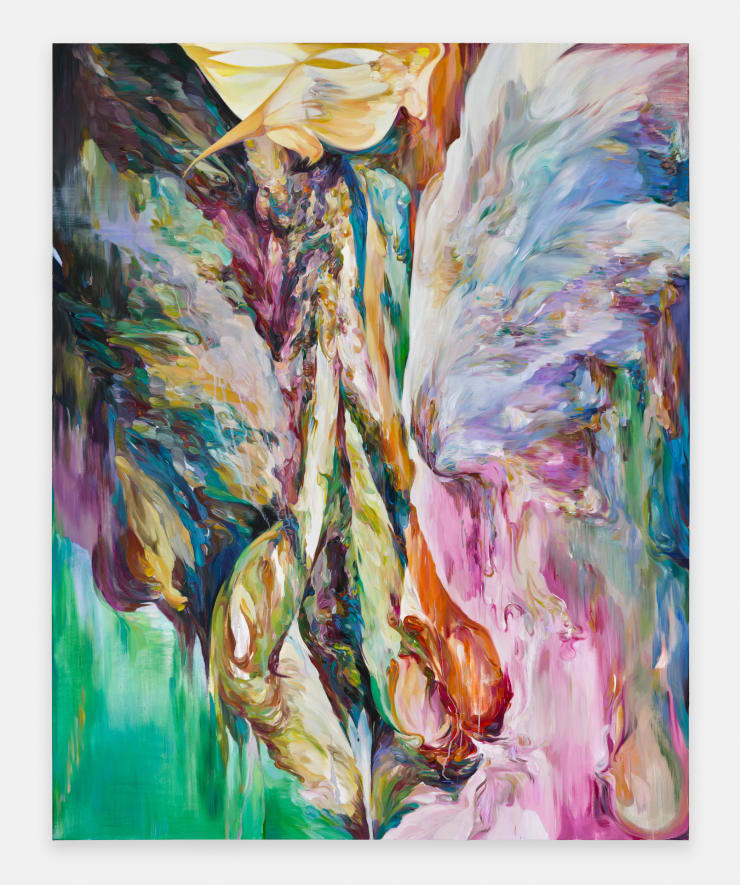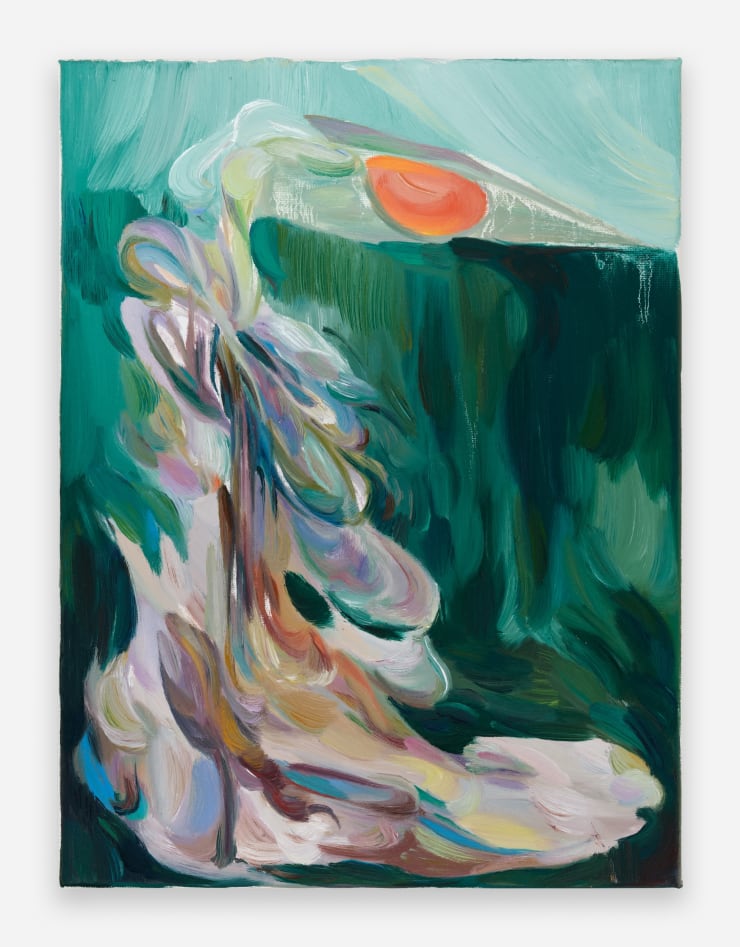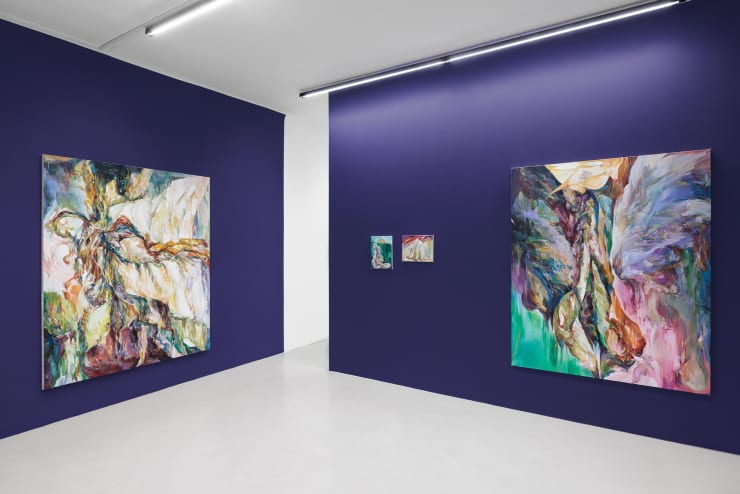Overview
Galerie Kandlhofer is pleased to present I’m similar, not similar to something, but just similar, a solo exhibition by YaYa Yajie Liang (b. 1995, Henan), whose paintings explore humanity’s complex relationship with the natural world. In a new body of works, Liang examines the connection of all life forms, where boundaries between human and non-human beings, organisms and non–organisms dissolve, evoking a deep awareness of moving beyond the Anthropocene to the Symbiosis.
YaYa Yajie Liang (b. 1995, Henan, China) has a BA Fine Art China Central Academy of Fine Arts (2018) and a MA Painting at Royal College of Art (2020). She is doing Ph.D. research at Royal College of Art since 2020.
Yaya Yajie Liang's work explores the metamorphosis of the body and the potential of 'becoming animal'. From the legendary banished beast to the interpenetration of biological space, Liang interrogates how men's analogic mapping to and from animals (within imagined, lived, or taxonomic intimacies) helps us to reconsider the prescribed definition of 'humanity'. Taking inspiration from Agential Realism, Liang views painting as a movement that is constantly repeating the 'becoming'. Shifting restlessly between abstract and figurative modes, she uses improvisation to kick-start new paintings, allowing unplanned initial strokes to help dictate the works' subsequent direction.
Her recent solo exhibitions included Particles Maze at Lyles & King, New York, NY (2024); Summer Palace, curated by Kat Sapera at Cob Gallery, London, UK (2023). Recent selected group shows include Embodied Forms, Thaddaeus Ropac, London, UK (2024); The Dance, Luce Gallery, Turin, IT (2023); Sweet Spot, BLANK Gallery, Shanghai, CH (2023); Wilderness of Being, HdM Gallery, London, UK (2022); Machines of Desire, Simon Lee Gallery, London, UK (2022); Beacon, Josh Lilly’s Gallery, London, UK (2020), among others. Liang has been shortlisted for The Waverton Art Prize in 2022. She has taken part in residency at Vannucci Artist Residency, Umbria, IT.
Works
-
 YaYa Yajie LiangHumus, 2024Oil on canvas220 x 180 cm.; 86 5/8 x 70 7/8 in.photo credits to Eva Herzog Studio
YaYa Yajie LiangHumus, 2024Oil on canvas220 x 180 cm.; 86 5/8 x 70 7/8 in.photo credits to Eva Herzog Studio -
 YaYa Yajie LiangThere shall be a fire that knows the naming of you, and in the presence of the strangling fruit, its dark flame shall acquire every part of you that remains, 2024Oil on canvas100 x 80 cm.; 39 3/8 x 31 1/2inphoto credits to Eva Herzog Studio
YaYa Yajie LiangThere shall be a fire that knows the naming of you, and in the presence of the strangling fruit, its dark flame shall acquire every part of you that remains, 2024Oil on canvas100 x 80 cm.; 39 3/8 x 31 1/2inphoto credits to Eva Herzog Studio -
 YaYa Yajie LiangThere was a sudden sunburst in my head. And then black night. That blackness was sublime. I felt distributed through space and time: One foot upon a mountaintop, one hand Under the pebbles of a panting strand, One ear in Italy, one eye in Spain, In caves, my blood, and in the stars, my brain. They were dull throbs in my Triassic; green Optical spots in Upper Pleistocene, An icy shiver down my Age of Stone, And all tomorrows in my funnybone., 2024Oil on canvas200 x 160 cm.; 78 3/4 x 63 in.photo credits to Eva Herzog Studio
YaYa Yajie LiangThere was a sudden sunburst in my head. And then black night. That blackness was sublime. I felt distributed through space and time: One foot upon a mountaintop, one hand Under the pebbles of a panting strand, One ear in Italy, one eye in Spain, In caves, my blood, and in the stars, my brain. They were dull throbs in my Triassic; green Optical spots in Upper Pleistocene, An icy shiver down my Age of Stone, And all tomorrows in my funnybone., 2024Oil on canvas200 x 160 cm.; 78 3/4 x 63 in.photo credits to Eva Herzog Studio -
 YaYa Yajie LiangMemories secrete Slime, sinking to the Seafloor, solidifying into Strangers., 2024Oil on canvas40 x 30 cm.; 15 3/4 x 11 13/16 in.photo credits to Eva Herzog Studio
YaYa Yajie LiangMemories secrete Slime, sinking to the Seafloor, solidifying into Strangers., 2024Oil on canvas40 x 30 cm.; 15 3/4 x 11 13/16 in.photo credits to Eva Herzog Studio -
 YaYa Yajie LiangWe are sleepwalkers. Moons adrift., 2024Oil on canvas30 x 40 cm.; 11 13/16 x 15 3/4 in.photo credits to Eva Herzog Studio
YaYa Yajie LiangWe are sleepwalkers. Moons adrift., 2024Oil on canvas30 x 40 cm.; 11 13/16 x 15 3/4 in.photo credits to Eva Herzog Studio
Press release
Galerie Kandlhofer is pleased to present I’m similar, not similar to something, but just similar, a solo exhibition by YaYa Yajie Liang (b. 1995, Henan), whose paintings explore humanity’s complex relationship with the natural world. In a new body of works, Liang examines the connection of all life forms, where boundaries between human and non-human beings, organisms and non–organisms dissolve, evoking a deep awareness of moving beyond the Anthropocene to the Symbiosis.
The works explore mimicry — a phenomenon in which life forms, from insects and animals to fungi, adopt visual strategies to imitate others, allowing them to connect, survive and blend into their surroundings. This concept draws on Roger Caillois’s essay Mimicry and Legendary Psychasthenia (1935), which examines biological aping strategies as a process which disperse the boundaries between self and environment, propelled by forces deeper than simple survival. For Caillois, mimicry represents not a rational adaptation but an existential dissolution, reflecting a drive to merge with the external world. In Liang’s work, mimicry unfolds as a metaphor for metamorphosis and interconnectedness. Rather than simply a tool for survival, mimicry here becomes a process of merging, challenging fixed identities and inviting viewers to contemplate how humanity might genuinely connect with and be reshaped by other life forms. This vision of mimicry reflects a deep-seated impulse towards interconnectedness, where the dissolution of boundaries between species is not only possible but intrinsic to rethinking coexistence in an entangled world.
At the heart of Liang’s practice is the notion of metamorphosis as a guiding principle for harmony, inviting a reconsideration of humans and their place in the ecological order. Her compositions, many of which are rooted in her personal experiences in nature, bring forth rich, enveloping colours and organic shapes that oscillate between recognisable forms and amorphous, biomorphic imagery. Liang’s work opens paths to examine our fragile eco-system, suggesting a route toward harmony and alliance with the natural world, particularly in response to a human-induced climate crisis. Drawing inspiration from both Eastern philosophies and and her own time spent in nature, her practice brings into focus a vision of life in which bodily desires and animal instincts exist within a dynamic network of interconnectivity and mutual existence.
Using oil paint with a fluid, tactile sensitivity, Liang creates an atmosphere that immerses viewers in swirling, meditative scenes that defy traditional boundaries between object and surrounding. Viewing the material as an interactive force, Liang’s paintings present a dialogue between artist, material, and environment, creating a porous space where human and animal, organic and inorganic coexist and thrive. The slow-drying nature of oil allows brushstrokes to flow and meld together, transforming the canvas into a living ecosystem where colours and forms merge autonomously. This intermingling of colours creates subtle shifts and blends, challenging the viewer’s sense of where one form ends and another begins. “Painting,” Liang notes, “becomes a living organism. The colour, the forms, which touch and bump and overlap each other, strain to separate themselves, yet cannot exist without one another. It’s just like life”.
Through the organic interplay of materials, Liang’s work invites viewers to engage deeply with a vision of life in which human existence is fully interwoven with nature. Her paintings act as a conduit, asking viewers to release their individual perspective and merge into the natural, spiritual, and bodily impulses that her works evoke.
Installation Views








